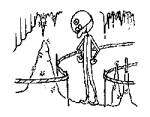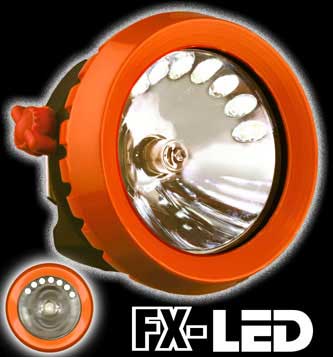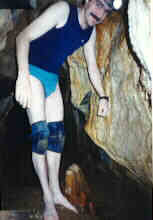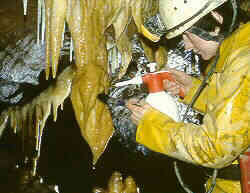|
              
 CAVE
PROTECTION CAVE
PROTECTION
...our point of view
Back to "Cave Protection
Home"
 The
first picture shows an average Belgian cave, which has suffered much from
overvisiting. All formations have been totally covered with mud, coming from
the muddy hands of careless visitors. The
first picture shows an average Belgian cave, which has suffered much from
overvisiting. All formations have been totally covered with mud, coming from
the muddy hands of careless visitors. 
In our club we do our utmost to protect the
underground environment. We are in a privileged position, since we have
known the pleasure to discover multiple new caves. So, we very well
know what a "virgin" passage looks like. Since the discoverer
is the first one to disturb such a virgin cave or gallery, the
consciousness or desire to protect all this, is very often a major
concern of those who actually discover caves... not of those who
visit caves...
Of course, over the years, we learned a lot about cave conservation,
and when we look back on the very first years of our careers, we must
admit that we too did fail sometimes (often due to ignorance,
unintentionally). Above all, we must blame the very poor training that
novice cavers receive: in a lot of clubs, and even federations,
training is focussed on caving techniques, not on cave protection!
Slowly, times are changing, but right now the situation is still quite miserable.
In our club, when training new members, we do pay a lot of attention
on all aspects of cave protection.
Some examples of our "cave protection rules" are:
 In Belgium, we do not use carbide
lighting (electric light only). Abroad, we only use it in
very big, non decorated caves, were autonomy and heat is important. Motivation: carbide is
very polluting. People often think that we mean the used-carbide
dumps, that one sees in most caves. Of course this is a very sad
thing, but it is perfectly possible to take all carbide waste out
of the cave and thus NOT pollute. No, it is especially the
production of soot that has devastating effects: it
floats through the air, carried by the draught In Belgium, we do not use carbide
lighting (electric light only). Abroad, we only use it in
very big, non decorated caves, were autonomy and heat is important. Motivation: carbide is
very polluting. People often think that we mean the used-carbide
dumps, that one sees in most caves. Of course this is a very sad
thing, but it is perfectly possible to take all carbide waste out
of the cave and thus NOT pollute. No, it is especially the
production of soot that has devastating effects: it
floats through the air, carried by the draught  (sometimes over
considerable distances: hundreds of metres), and it is deposited on
nearly every horizontal surface. At long term everything gets black
and grey. (see picture). Imagine the yearly soot-production in frequently visited
caves (Weron, Bernard, Haquin etc) that are visited weekly by
dozens of carbide-cavers! In all 3 of these caves, we have
discovered important prolongations: those (never visited) galleries
were black as night! In trou Weron, one of those discoveries has
been baptized "Réseau Noir" (translation: The Black
Network)
(sometimes over
considerable distances: hundreds of metres), and it is deposited on
nearly every horizontal surface. At long term everything gets black
and grey. (see picture). Imagine the yearly soot-production in frequently visited
caves (Weron, Bernard, Haquin etc) that are visited weekly by
dozens of carbide-cavers! In all 3 of these caves, we have
discovered important prolongations: those (never visited) galleries
were black as night! In trou Weron, one of those discoveries has
been baptized "Réseau Noir" (translation: The Black
Network)
- Formations are treated with respect:

we don't touch them; we
don't trample upon them with our (muddy) boots; we keep at a safe
distance. If physical contact is inevitable, we remove our boots or
even overalls (unless the formation is already muddied or ruined by
our colleagues!). Same rules apply in case of nice sediments (e.g. mud floors)
Have a look at this
picture of an
"explo in underpants"! Indeed, if even the
undersuit has become muddy, then exploring must continue...in
underpants!
- During al kinds of "digging
acitivities", we use our common sense:
the cave is of
paramount importance! As a result, in some of our discoveries, we
have NOT explored or worked in certain parts of the cave, because a
nice formation stood "in the way" or because the direct
surroundings did not permit it (nice sediments, formations etc..). Digging is often making a "result and loss" calculation.
In our club, the "loss" (= the damage to the cave) has to
be minimal, the "result" maximal. If uncertain about the
results, we don't start the dig... Of course, this is sometimes a
real dilemma. One of our discoveries; a very decorated room in a
very muddy cave, got its name (Salle du Dilemme) because of the
dilemma that we were confronted with (do we continue the
exploration, yes or no? ... we didn't!).
 The discoverer has a big responsibility: The discoverer has a big responsibility:
he/she
is in the first place responsible for the future protection and
even survival of the cave. We have always accepted this
responsibility! This means: taping off formations (with thin, red
rope) from the very first day of the discovery, constructing and
installing gates, or even re-closing (parts of) caves if they are
truly too valuable. This last measure is really exceptional and
we'll always try to find a solution that permits the cave to be
visited by the caving community
- Of course, we apply the "deontological
code" of our Federation (VVS):
we even made it more
severe! Example: we do not guide all kind of groups (scouts,
students, managers) around in caves! We'll only guide people who
are really interested in the underground world: max 4 people at a
time and without asking much money for it. Making money out of caving is, in our eyes, the most
rejectable thing a caver can do...
- We respect the surroundings of the cave;
the people who live nearby and the cave owners:

we try to be
discrete and always as diplomatic as possible.
- We
participate or organize "cleanup actions" in caves.
Examples: Galerie des Sources, Grotte du Maye-Crev? here we
cleaned up formations that were muddied or even stained with red paint!
See
picture.
- We have "adopted" 3 caves that we
discovered
(Grotte Strauss, Système de Bretaye and Grotte
aux Contrastes). A special contract was made and signed between the
Union Belge de Speleologie en SC Avalon.
 Finally a picture of an in 1998 held high-pressure cleaning
operation in a very decorated
cave, that unfortunately has been very damaged by visitors who have put
their muddy hands on the white formations (again: PLEASE DO NOT TOUCH FORMATIONS!). Finally a picture of an in 1998 held high-pressure cleaning
operation in a very decorated
cave, that unfortunately has been very damaged by visitors who have put
their muddy hands on the white formations (again: PLEASE DO NOT TOUCH FORMATIONS!).
We cleaned it with Karcher high-pressure cleaners. As you can see, 3/4 of the formation is already
snowwhite again (and 15 minutes later it was cleaned entirely). But it
does not always work that good, and organizing such operations is
difficult (you need electricity and a lot of water). .
|
